Hikers rescued from freezing conditions after mistaking Strava’s heat trail map for a footpath
The trekkers were saved from freezing, snowy conditions after the navigational blunder

Two hikers in Wales required urgent rescue last week after mistaking Strava’s heat trail map for a footpath. On November 18, a father and son duo were hiking the 3,261ft Glyder Fach Mountain in Eryri National Park, formerly Snowdonia, when they attempted to follow the heat trail map back down.
Realizing the error of their ways, the pair called for help, and a team from the Ogwen Valley Mountain Rescue Organization was quickly dispatched. Braving heavy snowfall and temperatures down to 16°F (-9°C), three rescuers ascended the mountain to aid the stranded pair.
“After supplying warm clothing and some fresh head torches, they were led back up to the summit, and then confidence-roped down Bristley Screes to Bwlch Tryfan,” the OVMRO explained on Facebook.
Strava’s heat map function offers hikers a visual representation of ground covered. It can be used to display how far you’ve traveled personally or offer a glimpse at the well-worn routes of other users.
While the heat maps function can be used to trace your steps, it's not an accurate depiction of footpaths or official walking routes. The function is also prone to issues that affect its usefulness as a navigation aid, such as disappearing when users are offline.
While mobile phones may sometimes suffice, especially if you have an iPhone with the SOS function, specialist GPS devices like the Garmin InReach are the safer choice for mountain navigation. Typically durable with long-lasting battery lives, these devices aren’t reliant on phone signals and can be used to call for help in the case of an emergency.

At the same time as that callout, a similarly unprepared pair of trekkers were saved on the nearby Tryfan mountain. With violent snowfall bringing much of the surrounding area to a standstill, the hikers became stranded wearing inappropriate gear for the harsh winter conditions.
Advnture Newsletter
All the latest inspiration, tips and guides to help you plan your next Advnture!
“Due to the deteriorating weather conditions, a hasty party was deployed to climb in and locate the pair, and supply warm clothing and head torches,” continued the OVMRO.
“A second team was deployed with rope rescue equipment, and the pair were lowered down the remainder of the gulley.”
Bombarded by worsening winter weather, the area has endured a brutal assault of snowfall and rain over the past week, with the UK's Meteorological Office warning of ‘mountain weather hazards’ and a ‘severe chill effect’.
Explaining the error of their ways, a spokesperson for the OVMRO told North Wales Online that: “Both casualty groups were very lucky. With temperatures down to -9, one group had no warm clothing or torches and were very cold and wet by the time they were found.”
If you’re thinking of heading up a snowy peak this winter, make sure to prepare well in advance by checking the weather forecast and heeding any official warnings.
Appropriate clothing is also essential. Warm winter layers can be life-saving in rescue situations while a sturdy pair of snow-ready hiking boots can help avoid nasty falls.
We ranked the Trango TRX Gore-Tex boots from La Sportiva as our best hiking boots for winter. Boasting a thick 1.6mm Idro-Perwanger leather outer and grippy Vibram sole, these boots are well equipped to handle all manner of backcountry conditions.
- Best winter hiking boots 2024 for unbeatable performance in the cold
- The best hiking boots 2024 keep your feet warm, dry and protected on the rails with our top choices

Will Symons developed his love of the outdoors as a student, exploring every inch of Sussex’s South Downs national park and wild swimming off the Brighton seafront. Now a Staff Writer for Advnture, Will previously worked as a freelance journalist and writer, covering everything from cricket to ancient history. Like most Advnture staff, Will’s time is rarely spent indoors, he can often be found hiking, wild swimming or playing cricket.
